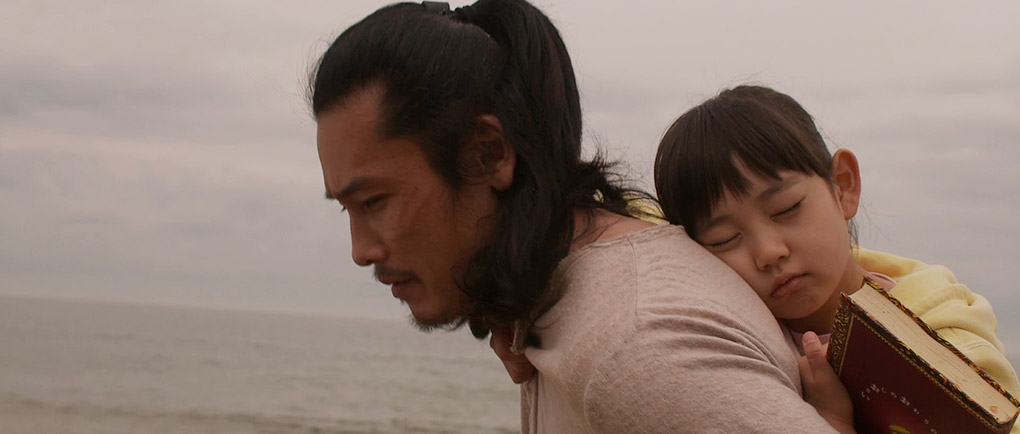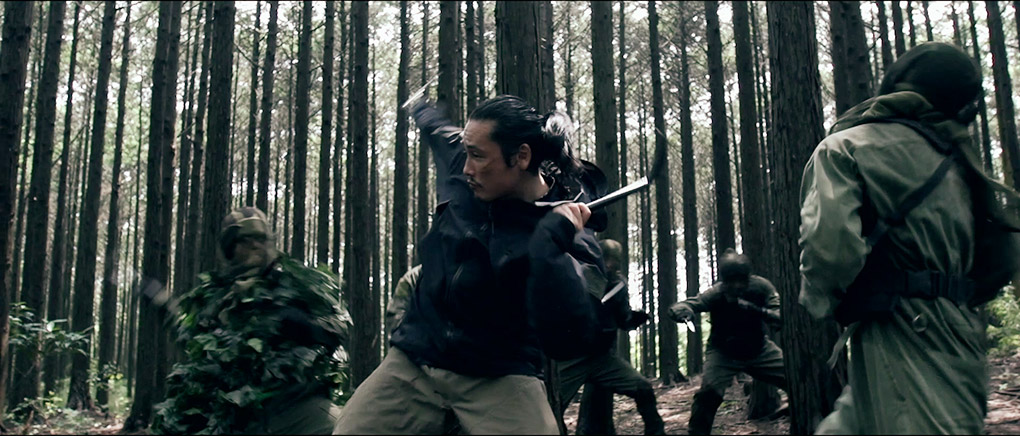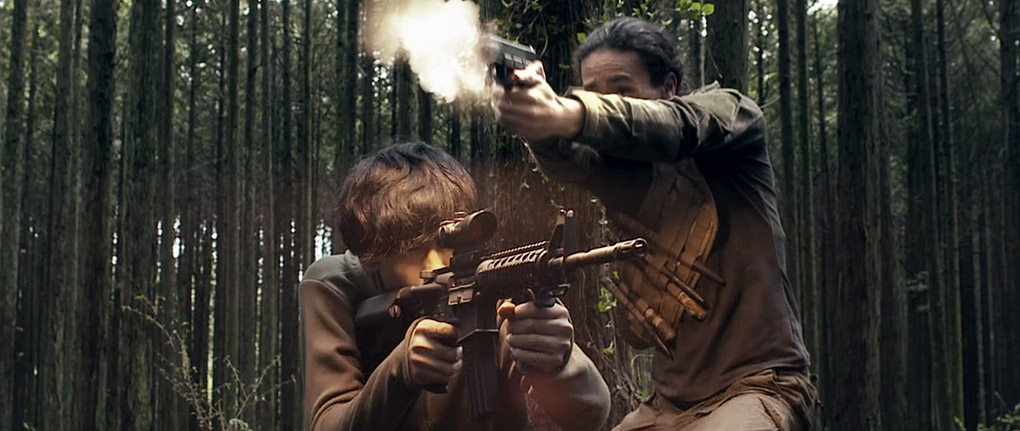|
How to write a reasonably detailed but spoiler-free synopsis for Re: Born? Difficult to do both, so let's go with spoiler-free. Toshiro is a former special unit soldier whose ability to sneak up undetected on enemies and take them down with anything that comes to hand has earned him the nickname 'Ghost'. Now retired after turning his back on his old unit, he runs a small shop and cares for a young girl named Sachi, but when his former commanding officer, a mysterious figure known as The Phantom, engages a small army of warriors to take him down, he is forced to call on his former skills to do battle with them and ultimately take the fight to The Phantom's door. What else can I safely reveal? There is a twist late in the first half that I saw coming a mile away but which is not quite what tradition leads us to believe. There's a female psychiatrist who is helping Toshiro confront his troubling dreams, and a former partner named Kenji who has been left disabled and disfigured by a pervious battle. And there are two men engaged by Kenji – veteran fighter Max and enthusiastic newcomer Masaru – to assist Toshiro, one of whose fate seems to be dictated by tradition. But the plot, which has its share of action movie clichés, is of little relevance here, as Re: Born is what I have repeatedly seen described as a "pure" action movie, one in which the action is the film's sole raison d'être. With that in mind, how does it measure up? Well, from this sometimes-twitchy viewer's perspective, there's good and not-so-good news.

Let's start with the good. The combat itself is most impressively staged, with a technique devised by director Shimomura Yuji, leading man Sakiguchi Taku (aka TAK∴) and fight choreographer Inagawa Yoshitaka that they have dubbed "zero-range combat" delivering some ferociously staged physical one-on-many battles. Their effectiveness is enhanced by a lack of obvious CG enhancement and an old-school approach to showcasing action that allows us to appreciate the fight skills of the performers instead of losing them in a blizzard of machine-gun edited shots.
The thing is, however, that these battles constitute a sizeable portion of the film's running time. The second half, in particular, is effectively an unbroken series of physical conflicts, and for all their choreographic smarts and wincing brutality, there's not much in the way of stylistic variance between them. As a result, well before the inevitable climactic fight, I found my interest waning, as one close combat battle in which Toshiro takes on multiple foes with fists and short blades and multiple throats are stabbed and slashed is followed by another, and another… It probably doesn't help that despite presenting Toshiro's skills as disarmingly plausible, there were a number of occasions in which an enemy soldier had a clear shot at Toshiro and chose not to fire or paused long enough to be violently disarmed by him. We're doubtless encouraged to accept that Toshiro's more fanciful ability to out-dodge a speeding bullet would have meant that the shots would not have hit him anyway, but I'm presuming the soldiers didn't know this (why have guns otherwise?) and every time a sildier hesitated, the voice of Peter Sellers as a frustrated Group Captain Lionel Mandrake from Dr. Strangelove popped into my head shouting, "Shoot! With a gun! That's what the bullets are for, you twit!" And after Toshiro has dispatched his first handful of foes in the blink of an eye without breaking a sweat (at one point he calmly kills five armed men who invade his shop one evening and then tucks into a freshly microwaved meal as if nothing had happened), you know without question that he's going to easily defeat anyone he runs into without getting so much as a scratch, at least until his inevitable climactic face-off with a similarly skilled former comrade codenamed Abyss (Inagawa Yoshitaka), which we are prompted to anticipate from an early stage. You thus never get the feeling that Toshiro is really in any danger, no matter how impossible the odds, and while this may be effective as a demonstration of his superhuman fighting skills, it effectively strips most of the pre-climax battles of any tension.

Hard core action fans are unlikely to have the same reaction, and the few reviews that I've read have all revelled in the non-stop barrage of close-combat mayhem. I'll admit that I had a similar reaction to John Wick, Chapter 2, which I caught up with recently, another film in which a threadbare plot is used as a launch pad for the impossibly skilled central character to do battle with a seemingly endless stream of foes in a relentless series of very violent confrontations. Like the first John Wick film (and, indeed, Re: Born), its strength lies in the fluidity of the action choreography, the physicality of its performers and the showcasing of the action, but in common with Re: Born, these action scenes lack much in the way of variety (Wick shoots two people, then grabs the arm of a third and uses that man's gun to kill a couple of others before turning the weapon on its owner), and so many people are killed in rapid succession that the experience becomes a little like watching someone else play a shoot-em-up video game. Human life counts for little in these movies, unless, of course, the human in question is given a dog or a small child to take care of.
If you're not remotely troubled by any of this, then you should have a ball. The fights may be samey, but they really are well choreographed and effectively captured on film. But if you like a little story or character depth with your action, and your combat scenes to imaginatively differentiate themselves from one another, then you may find yourself feeling a little short-changed before the end. And the film is not without its inventive scenes and moments, notably an extraordinary sequence in which Toshiro is attacked by a female assassin and the two slug it out inside the impossibly cramped confines of a telephone booth. A few more such scenes and I have a feeling I'd be more enthusiastically championing the film's action credentials.
A spotless 2.35:1 transfer with a strong level of picture detail and nicely graded contrast, though much of the film has a dark, moody look that doiesn't play well on plasma screens in a daylit room. The colour palette is deliberately muted, while the earthy inevitable tint that colours much of the film is not over-pronounced. Those who know their recording formats should have little trouble spotting that this was shot on digital rather than film, but the look suits the content and style of the film.

You can select between DTS-HD Master Audio and Linear PCM 2.0 stereo, both in the original Japanese. Sonically, there's not a huge difference between them – both are very clear with a strong dynamic range and reproduce all the exaggerated swooshes, thumps and slashes of combat at similar volume. The surround track has a tad more punch to the bass and it's a tad more inclusive, though is still largely front weighted.
The English subtitles can be switched off if desired.
Filmmaker Introduction (0:38)
Shimomura Yuji, Sakaguchi Taku and Inagawa Yoshitake introduce the film for this release at the Fighting Spirit Film Festival, and then perform the dual-shoulder punch seen in the film, a move that's doubtless meant to look more devastating than it does. The audience loves it, though.
Eureka! Trailer (1:39)
A snappily edited trailer that gives a small flavour of the action to come.
Original Theatrical Trailer (1:39)
A slightly better sell for the film's action credentials.
If you're looking for solid presentation of tightly choreographed, close-quarter fighting then there's no question that Re: Born delivers the goods. My gripes with it are likely a matter of personal taste. As a long-standing fan of martial arts cinema, I'm certainly used to plots playing second fiddle to the action set-pieces, but for me, these set-pieces cease to be as special when there are ten of them in a row and each is similar in content to the one that directly preceded it. But there are inventive sequences and touches here, and the avoidance of over-frantic editing allows us to appreciate the performers' considerable martial arts skills. Not much in the way of extra features on Eureka's Blu-ray, but the transfer is of the expected high quality.
The Japanese convention of surname first has been used for all Japanese names within this review.
|